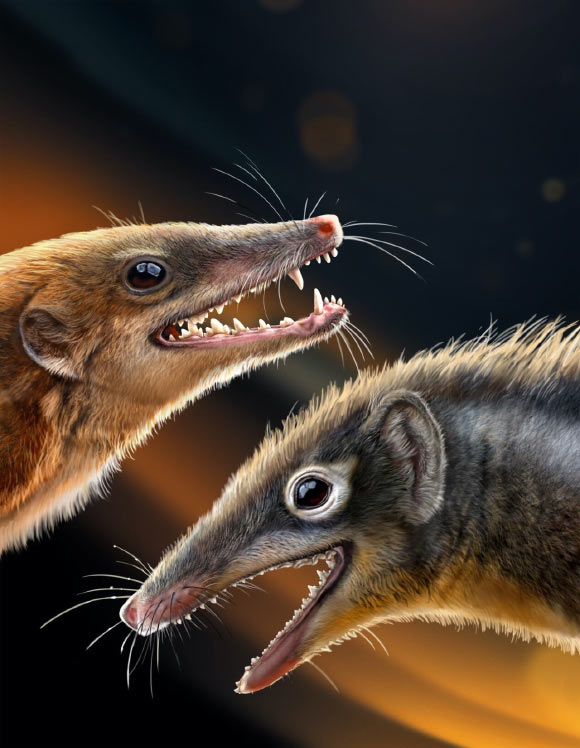In new research, a team of paleontologists examined the tooth structure of Feredocodon chowi, a new species of shuotheriid mammaliaform that lived in what is now China during the Jurassic period, to gain a better understanding of their phylogenetic relationships and evolutionary paths.
Life reconstruction of Feredocodon chowi (right) and Dianoconodon youngi (left). Image credit: Institute of Vertebrate Paleontology and Paleoanthropology, Chinese Academy of Sciences.
“Our study questions current theories and offers a new viewpoint on the evolutionary history of mammaliaforms,” said Professor Patricia Vickers-Rich, a researcher at Monash University and Museums Victoria.
“We provide vital insights into the phylogenetic relationships and evolutionary trajectories of shuotheriids, little known until recent discoveries in China, by explaining the intricate tooth shapes and occlusal patterns.”
Shuotheriids, mammal-like animals from the Jurassic period, have perplexed scientists because of their unique dental characteristics.
These creatures had what are termed pseudotribosphenic teeth, with a pseudotalonid (a basin-like structure) located in front of the trigonid in the lower molars, unlike the tribosphenic pattern seen in current therian mammals where the taloned is located behind the trigonid.
“This unique tooth pattern has hindered our comprehension of shuotheriid relationships and the first steps in the evolution of mammaliaform species,” Professor Vickers-Rich said.
Professor Vickers-Rich and her colleagues examined pseudotribosphenic teeth of a new Jurassic shuotheriid, Feredocodon chowi, represented by two skeletal specimens.
They were able to more fully analyze the dental structures using a variety of analysis, which suggested that shuotheriid dental structures appear to be very similar to those of docodontans.
The study suggests that shuotheriids do not have a genuine trigonid in their bottom teeth, indicating a closer relationship to docodontans than previously thought.
This reassessment of tooth architecture not only resolves unresolved interpretations but also triggers a reconsideration of the evolutionary connections within mammaliaforms.
“In 1982, a single Jurassic small lower jaw with four teeth was placed at one point on the mammalian family tree,” said Dr. Thomas Rich, also from Monash University and Museums Victoria.
“Now two virtually complete specimens, analyzed in a different way, places all of them in a quite different place on the mammalian family tree.”
“Additional specimens and different methods suggest different interpretations. This is how science often works.”
Based on the new data, shuotheriids appear to be in a different clade named Docodontiformes, separate from ausktribosphenids, and thus grouped with docodontans.
This discovery highlights the significance of pseudotribosphenic characteristics in elucidating the first diversification of mammaliaforms.
“The study emphasizes the presence of a significant variety of tooth morphology in early mammaliaforms, indicating unique ecomorphological adaptations throughout the evolutionary development within mammals,” Professor Vickers-Rich said.
“The dental modifications such as transverse broadening of posterior teeth, cusp rearrangement and even rotation indicate the many ecological niches early mammaliaforms inhabited.”
The findings appear today in the journal Nature.
_____
F. Mao et al. Jurassic shuotheriids show earliest dental diversification of mammaliaforms. Nature, published online April 3, 2024; doi: 10.1038/s41586-024-07258-7
>>> Read full article>>>
Copyright for syndicated content belongs to the linked Source : Breaking Science News – https://www.sci.news/paleontology/feredocodon-chowi-12820.html
